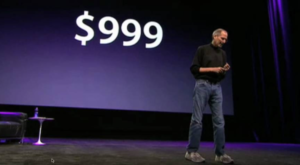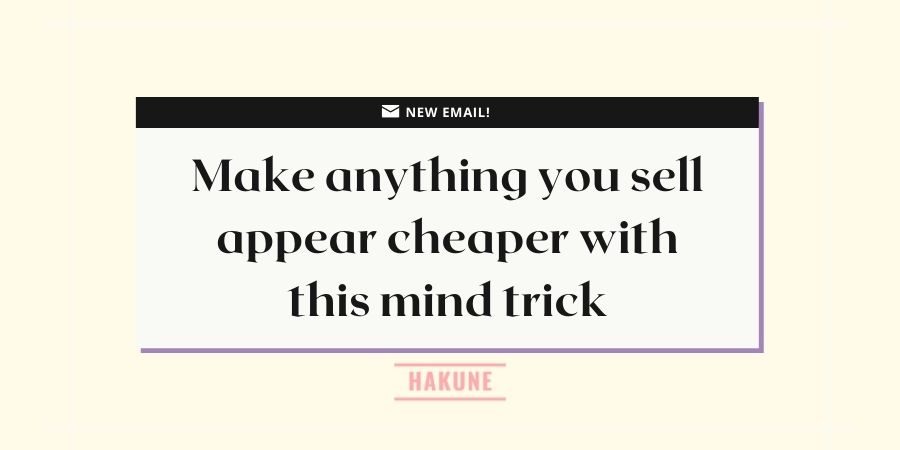The Method Episode #20

The Cognitive Bias That’ll Make Anything You Sell Appear Cheaper
The best way to sell a $10,000 car is to put it next to the $20,000 car in your yard.
Why? There’s this cognitive bias our minds have called anchoring. We use the first piece of information ($20,000 price) to decide about the second piece ($10,000 price).
It’s a well-known trick backed by a surprising amount of research that can help you sell more by making your goods and services appear cheaper than they are.
Steve Jobs was a big fan of price anchoring. In 2010, when he unveiled the iPad at one of his masterful product launches, he told the audience that analysts expected the price to be $999. He left that number on the big screen behind him as he continued his presentation.

When he revealed that the actual price was $499, he received a standing ovation. Anchored to $999 – $499 was a steal.
Real estate agents often employ this trick at open homes. In those little brochures they hand you as you walk in, they include information about recent sales of surrounding homes. And of course, they only show you info about houses that have sold for a price way above the one you’re viewing.
You can apply this technique to anything you’re trying to sell. Just make sure your anchor price is believable and not bullsh*t.
The real estate agent is using real data – just carefully selected. Steve Jobs was using real analyst expectations – again, carefully selected.

A Framework That Works Better Than Business Plans
We were lied to at business school; business plans just aren’t that important.
We’re part of many online communities for business owners and entrepreneurs. And one of the most common questions people ask goes something like, ‘can someone help me create a business plan for XYZ’.
These people often spend months – yes months, working on their business plans. That, like most plans, fall apart when they come into contact with reality.
There is some value in the exercise – a few well successful entrepreneurs (7 fig+ companies) we’ve spoken to lately believe creating them is a helpful thought exercise. ‘They make you think deeply about what you’re trying to achieve and how that will happen.‘
But sadly, the thought exercise is pretty much the limit of their value. Once you start building the A, B & Z framework is more practical.
Here’s how it works.
There are only three points in your business plan that matter when building.
• Your starting point (where you are now) = A
• Your next step (what you need to do next) = B
• Your vision (what you’re trying to achieve) = Z
Business plans try to cover every step in between. But things will change before you get to steps C through to Y, and you’ll have to adapt. You only need to know where you are, what you’ll do next, and what you’re ultimately working towards.
“Saving for a specific goal makes sense in a predictable world. But ours isn’t. Saving is a hedge against life’s inevitable ability to surprise the hell out of you at the worst possible moment.”
~ Morgan Housel
Where We’re Learning
• The Message Behind Fightclub -> A fascinating thread on the intricate messaging behind the movie fight club which seems more relevant today than ever.

Chaos And Order – What A Business Really Is
Operating a business, in its entirety, is an exercise in human psychology. You have to learn how to be comfortable with the uncomfortable and balance the predictable with the unpredictable.
A well-known and somewhat controversial psychologist likes to call this the balance of chaos and order. Where operating in a comfortable and predictable environment is orderly. And operating in an uncomfortable and unpredictable environment is chaotic.
All of us have a limit for chaos both personally and professionally. And there’s a fine line between enough and too much. As you know, too much can lead to array of unwanted financial and health problems.
So it’s sensible for us to seek as much order as possible in our business and in life so we have more capacity to deal with chaos.
The simplest way to create order is by building systems and processes and turning the parts your life and business that you can into a machine. Where inputs are turned into predictable outputs.
Some argue against this way of operating or viewing a business because it seems impersonal. But those same people are the ones who are constantly surprised by and can’t deal with unpredictable events. And so they don’t show up when needed for the very people they’re worried about treating impersonally.
The general point here is you can’t avoid all chaos – it’s part of the job. But you can do a lot to help yourself. The more order you introduce, the more you can handle.


